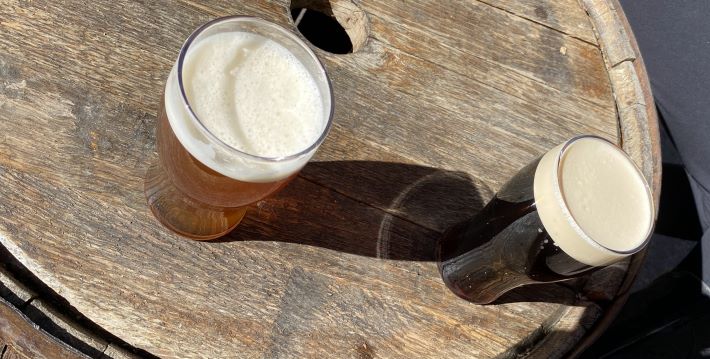
A decade ago, Asheville, North Carolina, provided New Belgium Brewing with $3.5 million in tax reimbursements as part of incentives to locate its second brewery not far from downtown. The city of Vista, California, has made breweries an important part of its economic development plan.
There are plenty more examples of cities recruiting breweries. But after reading “One polarizing brewery, six figures’ worth of tax incentives” you might pause and ask yourselves who much is it worth to you to have a brewery built in your home town.
Simply for pleasure . . .
Wandering the backstreets of Cologne in search of interesting boozers. “Might there be another Lommi or two lurking, round the back of a laundrette, near a discount supermarket, where the trams turn round?” Cue Tom Russell and “Back Streets of Love.”
. . . or not
The Beer Nut pulls no punches. “I find it difficult to believe that even the most ardent haze-pilled fanboi will enjoy what’s on offer here.”
Fortunately, there is always a next beer. “But much as it shouldn’t work, it’s absolutely beautiful, showing a lot of the joyous features of export-strength stout, but with lots of fresh hop topnotes. I’ll take another one like this, please.”
You might also enjoy
Fonio Rising
Brooklyn Brewery is releasing a beer made with the West African grain fonio.
“No fertilizers, no irrigation, no pesticides, no insecticides, no fungicides—- nothing. Whether you look at it from an environmental perspective, a social benefit perspective for the farming communities, or from a brewing perspective, fonio is so good that it seems like someone must have just made it up,” said brewmaster Garrett Oliver. “But fonio is real, and Africa grows 700,000 tons of it every year. Fonio is easy to brew with and gives beautiful flavors to beer.
“This is very exciting stuff, and I can easily envision a future where fonio is widely used as an everyday brewing ingredient, bringing vast benefits to brewers, beer drinkers, farmers and the planet.”
Yes to brewers using a sustainable grain grown near where they make beer. Shipping it all over the world? Not quite as sustainable.
The Legacy of Double Diamond Burton Pale Ale
To which I will add, in the mid-90s in the Midwest many “good beer bars” served a Double Diamond, which was imported from the UK. At the Union Jack Pub in Indianapolis they pulled it from a tap handle that suggested it was a cask ale (it was not). Its most prominent feature, no matter where you tried it, was diacetyl.
What’s So Special About Extra Special Bitter, Anyway?
An aside, Double Diamond was often billed, again in the Midwest, an ESB (it was not even close). If ESB is to be more than an oddity drinkers who crave it should know there are locations where they will find it on all the time. My top three choices in Denver-ish are: Sawtooth Ale (granted, a bitter, but as Left Hand Brewing boasts, it is “timeless”) at Left Hand Rino; Chosen Family ESB at Lady Justice Brewing; and cask-conditioned Hogshead Brewery Chin Wag (pictured at the top along with Gilpin Black Gold, a porter).
Pale ales, American IPA & Hazy IPA; that’s it?
Jeff Alworth asks “what were the watershed beers that transformed American beer in this craft era?” Not to be a contrarian, but I prefer to spend time considering the ones he calls the “character actors of the beer world.” Find me a beer that is as interesting as the work of everyone on this list.
A Beer’s Birthplace Is No Longer the Be-All and End-All
Moving on, and being a contrarian . . . Drinkers might be drawn to the beers mentioned in this story because of their import cache, but they are better because they are brewed locally. Thus, birthplace matters.
12 Mistakes You’re Making When Visiting A Brewery
AI written? Consider, for instance, No. 2, Dressing inappropriately. “As a rule of thumb, it’s a good idea to dress for a brewery as if you were dressing for a construction site. While you won’t need to bring your own hard hat and high-vis jacket – breweries tend to provide these if it’s considered necessary – durable, closed-toe shoes with a grippy sole are a must if you’re going for a walk on the brewery floor.” And you just wanted to sit down and enjoy a beer.
One alcoholic drink can shift your morality.
Who finances research like this? This one “discovered intoxicated participants had a greater willingness to consider engaging in impure behaviour, such as attending an event where participants act like animals, ‘crawling around naked and urinating on stage.'”
Back to your Monday morning. Have a productive week. I’ll be out of the country much of it and am not certain if I will be posting links next Monday.
In theory “road miles” for brewing ingredients is a negative from a sustainability standpoint. However, the largest carbon input in malt production isn’t transport of finished goods, or gas and electricity used in the malting process, it is by far the growing of the grain itself. Specifically fertilizers used in grain cultivation.
A more sustainably grown grain from halfway around the world has a lower carbon footprint than a less sustainably grown grain locally.
I worked with Dr. Nigel Davies when he and I worked for Muntons Malt. When I was there the company did a ton of work on sustainability, and Nigel shared some of the work the company did on coming up with a carbon footprint for malt with the MBAA.
https://www.muntons-inc.com/wp-content/uploads/2021/01/Master-Brewers-Association-of-the-Americas-MBAA-2021.pdf
https://www.masterbrewerspodcast.com/guests/nigel-davies
Thanks, Jason. And the same it true of hops. As well as fertilizer, spraying for diseases can add significantly to the carbon footprint. That’s why breeding of disease resistance is so important.